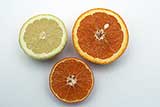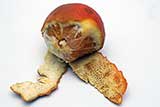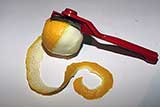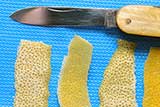Meats and Sausages
Citrus Vodkas
Citrus vodkas, orange or lemon, have always been popular everywhere. When we eat our oranges or lemons, we usually peel away the thick layer of skin and remove the bitter white part, also known as pith. It is the white flesh lying under the rind, between the rind and the pulp. We do not want the pith because it is bitter. Any white membrane that covers the fruit should be discarded as well. In addition to their bitterness, the pith and membranes contain plenty of pectin (commercial pectin is produced from citrus skins). Pectin is used for making gels that we use to make jams, jellies and marmalades. Pectin is also responsible for making citrus fruit cloudy so its amount should be limited to a minimum. Discard as much pith as practically possible but save the skin for skin infusion.
Most of the lemon or orange flavor is locked inside the skin. Juices from tropical fruits such as lemon, orange, banana and others are usually cloudy, so even a well filtered infusion may not be perfectly clear. The hardest to filter is lemon juice and even factory made lemon vodkas tend to be cloudy. When lemons or oranges are added whole they should be separated into little wedges, and all white membranes, seeds and skins should be removed. There is a variety of tools that efficiently extract juice from lemons or oranges. There are manual juicers, lever operated squeezers and electrical models, too. Mix juice with alcohol and let it macerate. Then strain the infusion and filter. A little lemon skin extract/infusion is usually added to orange vodkas. By the same token lemon vodka will benefit from a little orange flavor.
The easiest method to produce quality citrus vodka is to:
- Mix a natural essential oil with alcohol OR:
- Mix orange or lemon skin infusion with alcohol.
Using a natural essential orange oil or homemade extract infusion from lemon or orange skins will produce a perfectly clear vodka. Clear vodkas generally contain more fruit infusion and are sweeter. Their color is more intense.
Citrus juice may be preserved for future use:
- 150 ml fresh lemon/orange juice (about 3 fruit).
- 75% alcohol, 50 ml.
- Macerate for 10 days, then filter. The alcohol strength of the juice is 18% which makes it safe to store.
- Such juice infusions can be bottled or immediately used for making vodka.
Orange Vodkas
Oranges are not fully matured when distributed to stores. They contain a lot of flesh in their rind which decreases in time as the orange dries out. The best oranges will be fully ripened fruits, still hanging from a tree. These oranges contain very little pith. The clearest vodka is made from orange skin infusion. Adding a 10% lemon skin infusion in relation to orange skin infusion rounds out the flavor nicely. For 250 ml of orange skin infusion add 25 ml (about 2 tablespoons) of lemon skin infusion.
The basic process:
- Make orange skin infusion. Remove white under skin flesh known as pith.
Orange Skins Fresh - 100 g, Alcohol 70%, 500 ml Maceration Time 3 - 4 days
Orange Skins Dry - 100 g, Alcohol 50%, 500 ml Maceration Time 7 days
Strain and filter. About 250 ml of orange skin infusion is added for making orange vodka. Often added ingredients are ginger, orange skin, vanilla. - Add sugar, spices and flavorings.
- Add water to arrive at 40% strength.
- Bottle and age at least 2 days.
Depending on the amount of sugar orange vodkas can be
- Dry - up to 50 g of sugar per 1 liter.
- Semi-sweet - 51-120 g/l.
- Sweet - 121-300 g/l.
Anything sweeter will be classified as a liqueur. Other ingredients which are commonly added are: lemon skin, cloves, vanilla.
Lemon Vodkas
The manufacturing of lemon vodka follows the same procedure for making orange vodka. The easiest method is just to add a few lemon skins into plain vodka and wait a few days for the flavor to set in. Use only fully matured yellow lemons. If you make lemon vodka from skins only, it will have a nice aroma and will be crystal clear. However, if you use lemon skin extract alone you will get plenty of aroma, but you will notice that the drink will benefit from more acidity. If you add lemon juice you will lose some clarity so the best approach is to add some citric acid (0.1%, 1 g/l). Taste and add more if needed. Citric acid is made from lemons so it is a natural combination. If fresh lemon juice or lemon infusion is added, adding citric acid should be avoided as the drink may become overly sour. Adding 10% orange skin infusion in relation to lemon skin infusion improves the flavor nicely. For 250 ml of lemon skin infusion add 25 ml (about 2 tablespoons) of orange skin infusion. Adding sugar is up to you but most people like between 5-10% (50-100 g/l).
Lemon skins infusion:
Lemon Skins Fresh - 100 g, Alcohol 70%, 500 ml Maceration Time 3 - 4 days
Lemon Skin Dry - 100 g, Alcohol 50%, 500 ml Maceration Time 7
Strain and filter. About 250 ml of lemon skin infusion is added for making lemon vodka. Often added ingredients are ginger, orange skin, vanilla.
Grapefruit Vodkas
Grapefruits, white or pink, make wonderful vodkas and they do not need other ingredients. What is most surprising is how clear the filtered infusion comes out.
Because grapefruit infusions are crystal clear, they can be added to many sweet infusions or honey vodka to offset some of the sweetness. Kiwi can be used for the same purpose, although grapefruit is more sour.





















